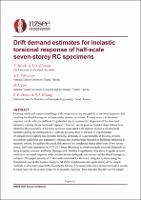| dc.description.abstract | Existing reinforced concrete buildings with irregularities are susceptible to torsional response and resulting localised damage or collapse under seismic excitation. Primary source of torsional response can be inherent stiffness irregularities due to asymmetric alignment of the structural elements, causing elastic torsional response. However, recent post-earthquake observations have identified the possibility of torsional response associated with inelastic response of structural elements during the earthquake (i.e. inelastic torsion). Due to the lack of experimental investigations to capture real inelastic torsional demands, it is questionable if existing seismic assessment guidelines can adequately estimate the displacement demand on buildings subjected to inelastic torsion. To address this need, this project first conducted shake-table tests of two seven-storey, half-scale specimens in NCREE Tainan laboratory to obtain inelastic torsional demands on three irregular systems: Stiffness, Damage and Ductility irregularities. The three irregular systems resulted in torsional response under unidirectional earthquake excitations and localised damage or collapse. This paper presents drift demands estimated for the tested irregular systems using the Simplified Lateral Mechanism Analysis, SLaMA, and discusses the applicability of the simple methods to structures susceptible to inelastic torsion. The assessment showed unconservative results in most cases for the system subjected to inelastic response. This indicates that the current simple seismic assessment procedures may require modification to estimate the displacement demands due to inelastic torsional response. | |

